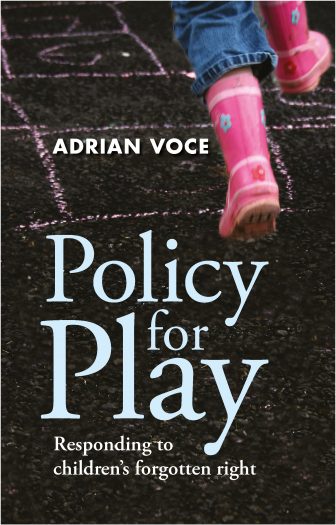
Children’s need to play demands a long term strategy
Ahead of the Child in the City international seminar on children’s play to be held in London on 6-7 November, we feature the third and final part of an adapted extract from Policy for Play by Adrian Voce, who will chair the event.
The only logical response to both the growing evidence of children being denied the space and opportunity to play that science tells us they need, and the obligations that we have to children as set out in the UNCRC and General Comment 17, is a cross-cutting, long term plan at the most senior level of government.
The particulars of such a strategy should be determined by local circumstance and context, informed by evidence and analysis of current play behaviours, children’s access to and use of space – and the barriers to it. In the England context, a meaningful, impactful national play policy should contain the following.
A cabinet minister for children
A prerequisite for the kind of changes that are needed, implicit in the UN’s General Comment (2013), is a recognition at the top level of government that children’s right to play is of equal significance to their wellbeing and future life chances as their other rights under the CRC. This needs a secretary of state not just for education, but for children.
A cross-departmental plan for play
Planning; architecture and landscape architecture; traffic; police; housing; parks; leisure and cultural services; schools and children’s services, early years’ and childcare provision, as well as play services themselves, each have a significant role in either inhibiting or enabling children’s play. Logically, then, the national government should produce and implement a long-term, cross-departmental national strategy to identify and effect the necessary changes to policy and practice within each of these areas, according to a common set of understandings about the nature of play and playable space.
Planning policy
National policy and guidance should place a duty on planning authorities to ensure minimum qualitative and quantitative standards for children’s play space in new developments, supported by good practice guidance for the creation of child-friendly public space within spatial development strategies, local development frameworks and relevant master plans (such as the Mayor of London, 2006).
Traffic management
Departments for transport and highways should collaborate with planning policy to calm traffic flow in residential areas and around children’s transit routes, introducing ‘shared space’ streetscapes, ‘Home Zones’, pedestrian areas and play streets wherever possible, with lower (15 or 20mph) speed limits as the norm for residential streets in general.
Playwork and playwork services
A national play strategy should review and evaluate the adventure playground network and introduce a long-term sustainable development plan for this valuable and unique form of provision. Professional playwork should be fully supported by government policies for workforce development, and playwork services should be fully recognised by the relevant registration and inspection regimes, whose criteria should be based on good playwork practice.
Childcare and extended services
Children should be able to play freely after school in whatever environment they find themselves. School-aged childcare, afterschool clubs and ‘extended services’ should contain: a basic offer of playwork provision, appropriately staffed by qualified practitioners; enriched play environments, including a requirement for outdoor space, as identified by good playwork practice; greater parity between the status, terms and conditions of teachers, playworkers and childcare staff; and inspection against criteria that is consistent with playwork theory and practice.
Cross-professional training
A key to an effective local play strategy will be the proactive cultivation of a better, evidence-based understanding of children’s play within the professional sectors that conceive, design, develop and manage public space, particularly in residential areas and the transit routes between homes and schools, sports and leisure centres, parks and other open spaces.
Statutory play duty on local authorities
The impact of the play sufficiency duty in Wales has yet to be authoritatively evaluated but, as an interviewee in Lester and Russell’s (2013) early analysis found, there is ‘a sense of excitement’ around the process and a ‘collective wisdom’ emerging through ‘supportive and collaborative networks … within a community of practice of adults looking to support children’s play’. The UK government – indeed any developed world national government interested in meeting its obligations under Article 31 – should monitor this work and explore its potential for replication.
Adrian Voce
Photo: Howard Ignatius
Part one of this article can be read here, and part two here.
References
Committee on the Rights of the Child (CRC), 2013, Article 31: General comment no. 17 on the right of the child to rest, leisure, play, recreational activities, cultural life and the arts, adopted 17 April 2013, available from: http://www2.ohchr.org
Department for Children, Schools and Families (DCSF) /Department for Culture, Media and Sport (DCMS), 2008, The play strategy, London: Crown Copyright
Lester, S and Russell, W, 2013, Leopard skin wellies, a top hat and a vacuum cleaner hose: An analysis of Wales’s play sufficiency assessment duty, Cardiff: Play Wales / University of Gloucestershire
Mayor of London, 2008, Supplementary planning guidance: Providing for children and young people’s play and informal recreation, London: Greater London Authority.

Policy for Play – responding to children’s forgotten right
by Adrian Voce (with a foreword by Roger Hart)
Published by Policy Press (2015)





